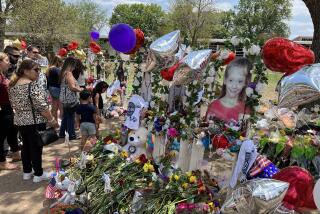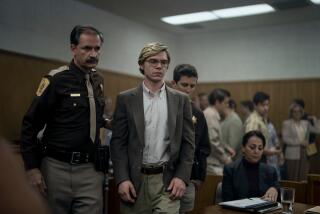100 Years of ‘Isolated Incidents’
- Share via
I was slaving over a hot word processor and listening to FM radio when they interrupted the program to report what happened Saturday night near Jasper, Texas. How a 49-year-old black man with a crippled left hand was dragged by a chain from the back of a pickup truck for 2 1/2 miles. How his body had disintegrated into 75 pieces--leaving his head and arm to be found a mile from his torso, his dentures someplace else. How three white men with racial motivations were suspected of his murder.
I shook my head once and went back to work. Maybe I’m jaded. But I happened to be writing about the 1986 incident in the New York City neighborhood of Howard Beach, in which at least a dozen young white males found three young black males who were peacefully eating pizza and set upon them with tree limbs, bricks and baseball bats, eventually chasing one onto the Belt Parkway, where he was killed by a car. This incident should not be confused with the 1989 incident in Bensonhurst, another New York City neighborhood, in which at least five young white males attacked young black males who were looking to buy a used car, shooting one to death. Which should not be confused with the 1997 incident near Independence, Va., in which two 30-something white males doused a 40-year-old black male with gasoline, set him afire and then beheaded his well-done carcass with a dull ax. Which should not to be confused with the Texas case--though it easily might be.
And none of them will be confused with the riot in Tulsa, Okla.--it’s the 77th anniversary this year--when white mobs killed as many as 300 blacks, because they had been frustrated in their attempts to lynch a single black man.
I find it curious because recently other disturbing and tragic events--incidents of shootings in schools around the country--have been seen as a grand wave of inexplicable disorder; some reports have used the term “copycat.” I do not say this is unjustified; there is clear evidence that some of those school incidents have been inspired by previous ones. But even if no such connection is apparent, media treatment and the opinions of experts suggest there is some kind of atmosphere in our society that has compelled these young people to start blowing their classmates away.
But the same suggestion is not made with respect to racial killings. Rather, the reverse. These, we are told, are “isolated incidents” despite the fact that there have been copycat killings of black men in America for at least 110 years. And yes, there is a name for them: lynchings.
About this our society is in determined denial. Even to use the word “lynching” is to risk being accused of the worst kind of demagoguery.
The fact is that unlike school shootings, lynching is a well-understood American social phenomenon. A journalistic expose written by Ida B. Wells 100 years ago indicated that sex had nothing to do with it. Half a century ago, Oliver C. Cox defined lynching precisely: “An act of homicidal aggression committed by one people against another through mob action for the purpose of suppressing either some tendency in the latter to rise from an accommodated position of subordination or for subjugating them further to some lower social status.”
More, there is a deep social understanding not only of what lynching is, but of how it is done. Obviously, the pair in Independence, Va., did not invent the ritual. Obviously, the how-to details are part of our collective American unconsciousness.
We do not know what causes school shootings, but we are doing everything we can do to stop them. We do know what causes this kind of racial violence, and we do almost nothing at all.
What can we do? We can, for one thing, never forget that such crimes have taken place. We can apply our modern forensic techniques to bring to justice past perpetrators, as has recently been done in Mississippi. And we can look to the social science literature to develop profiles of likely lynchers and likely lynching situations, just as the police profile likely offenders or as we now watch for “danger signals” among children in our schools.
But society at large is not a school. The perpetrators of racial violence are not often juveniles. Surveillance, gun control and intervention are limited by the Bill of Rights--properly so.
What is not limited by the Bill of Rights is the level of social concern--the focus of the media and the focus of public discussion. We can, as a society, force ourselves to put two and two together. Any resident of Southern California who reads of Jasper, Texas, and does not immediately recall, with a chill of horror, the boastful statements about burning black Americans made by a former Los Angeles policeman is part of the problem.
On the same day that wire services reported the charging of the three suspects in Texas, they also carried a story about President Clinton’s year-old initiative for a national dialogue on race. White House sources insisted that the initiative had accomplished its main goal: to get people talking about race. But they admitted that the conversations have not been very deep because Americans, especially white Americans, don’t feel comfortable talking about racial feelings “in polite company.” Maybe.
But the fact is, some white Americans feel all too comfortable acting out racial feelings. What took place in Texas was not an isolated incident; it was the most recent repetition of a century-old ritual. If we as a society truly are shocked, if we truly wish this pattern to be a matter of history, not current events, we must respond to the lynching of a black man with the same desperate self-examination as we do to a shooting in a school.
More to Read
Sign up for Essential California
The most important California stories and recommendations in your inbox every morning.
You may occasionally receive promotional content from the Los Angeles Times.












